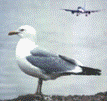Bird Strike Committee Proceedings

Bird Strike Committee-USA/Canada Joint Annual Meeting: 8th (2006)
Date of this Version
August 2006
Document Type
Article
Abstract
All but a few North American bats are insectivorous and weigh less than 35 g, but this diverse group of mammals also contains species with wingspans up to 2 meters and weighing a kg or more. Even small-bodied bats can cause considerable damage when encountered in swarms. When aircraft head into new territory and encounter strikes, the ability to identify the species of bat struck is paramount to preventing future strikes. Identifications of bats from fragmentary evidence are made by comparing samples recovered from aircraft with specimens housed in the Smithsonian Institution’s National Museum of Natural History. This collection, worldwide in scope, is the largest collection of mammal specimens in existence. The species of bat most frequently identified in U.S. Air Force aircraft strikes is the Brazilian free-tailed bat, Tadarida brasiliensis (38%). Tree bats, which include the red bat, Lasiurus borealis (19%), Seminole bat, L. seminolus (7%), and hoary bat, L. cinereus (13%), along with strikes identified only to the genus level, collectively comprise 44% of identified bat strikes. The information obtained from these identifications has already greatly enhanced our understanding of when and where bats are flying. The data associated with these aircraft strikes in respect to date, time, location, and altitude of flight may also provide important insights for other projects, such as the development of wind energy resources.

